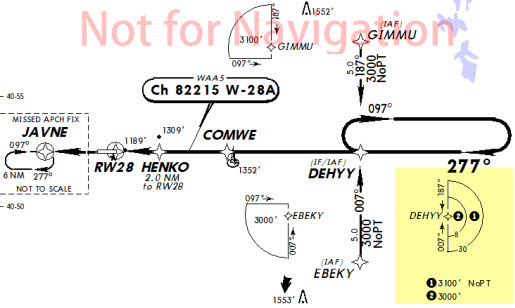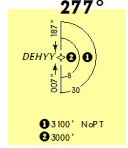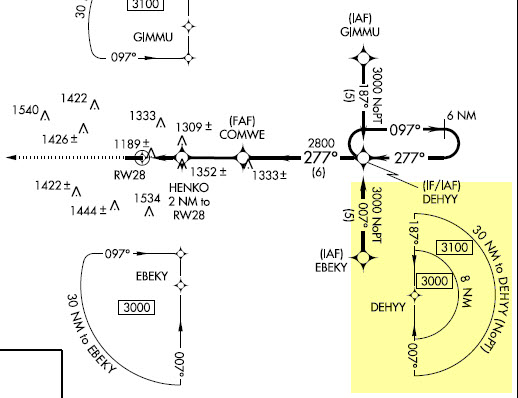Procedure Turn Not Required
A good pilot is always learning right? Well, I have learned something recently about TAA approaches, procedure turns and how they are charted, especially on the Jeppesen charts. To begin, let’s take a look at this traditional RNAV / GPS approach:
 This is a standard “Basic T” approach that uses a Terminal Arrival Area (TAA) to assist with the transition from the enroute structure to the terminal environment. You can see how this approach has the 3 standard IAFs (initial approach fix)i to guide you to the intermediate leg, which is the approach leg located between the intermediate fix (IF) and the final approach fix (FAF). In this case, DEHYY serves as both a IAF and the IF. If you given DEHYY as your IAF, you will either have to fly the procedure turn (PT) or NOT fly the procedure turn based on your arrival area. Since the procedure turn is drawn with a black bold line, we know that it is a charted published portion of the approach, again only if the requirements for flying the procedure turn are met. You’ll notice that if EBEKY or GIMMU were your IAFs, then you are not to fly the procedure turn as it very clearly states in the plan view “NoPT”. You’ll also notice that in the “straight-in” area that there are two segments or step downs that are defined by the distance to the IAF, in this case DEHYY. There is a 30 NM, 3100′ segment and a 8 NM, 3000′ segment to DEHYY in the straight-in area. I have highlighted this straight-in area in yellow on the approach plate above.
This is a standard “Basic T” approach that uses a Terminal Arrival Area (TAA) to assist with the transition from the enroute structure to the terminal environment. You can see how this approach has the 3 standard IAFs (initial approach fix)i to guide you to the intermediate leg, which is the approach leg located between the intermediate fix (IF) and the final approach fix (FAF). In this case, DEHYY serves as both a IAF and the IF. If you given DEHYY as your IAF, you will either have to fly the procedure turn (PT) or NOT fly the procedure turn based on your arrival area. Since the procedure turn is drawn with a black bold line, we know that it is a charted published portion of the approach, again only if the requirements for flying the procedure turn are met. You’ll notice that if EBEKY or GIMMU were your IAFs, then you are not to fly the procedure turn as it very clearly states in the plan view “NoPT”. You’ll also notice that in the “straight-in” area that there are two segments or step downs that are defined by the distance to the IAF, in this case DEHYY. There is a 30 NM, 3100′ segment and a 8 NM, 3000′ segment to DEHYY in the straight-in area. I have highlighted this straight-in area in yellow on the approach plate above.
I was on a very (very) short reposition flight to airport that was located about 10 miles away from my departure airport. After takeoff I climbed up to 3,000 feet (my initial and final altitude) and almost immediately after my initial contact with departure control I heard the words “Cleared direct to DEHYY, maintain 3,000 until established, cleared for the GPS RNAV Runway 28 approach.” Ok, no big deal, I’m doing the full approach on my own. I loaded the approach in the FMS and proceeded direct to the initial approach fix (IAF) of DEHYY. Like I said, this was a short flight and I was pretty busy with the after takeoff, descent and approach checklists. Never mind that I had to double check my Vref speed, set the VNAV minimums in the autopoilot and obtain the latest weather on ASOS! I had just enough time to glance down at my Jeppesen approach plate and read the notes associated with using DEHYY as the initial fix. I saw the “1” and “2” and quickly determined that because I was at 3,000 feet and within 8 miles of DEHYY, the procedure turn IS required because I don’t see the words “NoPT” like I did see for the 30 miles and 3100′ transition or the north (GIMMU) and south (EBEKY) transitions. I WAS WRONG!
I started the procedure turn outbound and heard approach ask, “Are you headed eastbound?” “Yes,” was my response. All I heard as a response initially was quiet….that’s not good. “Ok, call us inbound” “Roger”, I replied. “Oh, and if you wouldn’t mind please calling me when you get on the ground too” Oh boy, that’s definitely not good.
 Make a long story short, after calling approach and contacting the Jeppesen charting office, I learned something very important about how transitions and procedure turns are charted. When there is a common transition to a fix, the “NoPT” is only added to the first leg of the transition. (please read that twice). For instance, if you look at the above approach plate, you can see that the words “NoPT” are placed next to the 3,100′ and 30 NM transition but not to the 8 NM and 3,000′ portion. Although it is not explicitly stated, the procedure turn is NOT authorized for that leg of the transition as well! Did you know that? I sure didn’t.
Make a long story short, after calling approach and contacting the Jeppesen charting office, I learned something very important about how transitions and procedure turns are charted. When there is a common transition to a fix, the “NoPT” is only added to the first leg of the transition. (please read that twice). For instance, if you look at the above approach plate, you can see that the words “NoPT” are placed next to the 3,100′ and 30 NM transition but not to the 8 NM and 3,000′ portion. Although it is not explicitly stated, the procedure turn is NOT authorized for that leg of the transition as well! Did you know that? I sure didn’t.
Now that some time has passed and I’ve thought about it, it makes a lot of sense that I didn’t have to do the procedure turn. However, at the time, all I knew was that I didn’t see the words “NoPT” beside my transition, so I thought that the procedure turn was required.
I took a look at the NACO chart for the same airport, and to be honest, the NACO chart makes it a little clearer that a procedure turn within that 8 mile, 3,000′ transition is not required but it leaves some room for question. Here is the same approach:
 On the NACO chart you can see that “NoPT” is added for that entire straight-in transition area (187 ° through 007°) and by the way that it is drawn it does a little better job of implying that that procedure turn is not to be flown while in either steps of this transition (3,100′ and 3,000′).
On the NACO chart you can see that “NoPT” is added for that entire straight-in transition area (187 ° through 007°) and by the way that it is drawn it does a little better job of implying that that procedure turn is not to be flown while in either steps of this transition (3,100′ and 3,000′).
Do you know when else you are not required to do the Procedure Turn?
1) When the symbol “No PT” is depicted on the initial segment being used
2) When receiving radar vectors to the final approach course
3) When conducting a timed approach from a holding fix
4)When ATC specifies in the approach clearance “Cleared Straight-In (type) approach”
5) When a teardrop procedure turn is depicted and a course reversal is required, this type turn my be executed.
6) When a holding pattern replaces a procedure turn, then the holding pattern must be followed (unless you meet one of the above rules)
7) When the procedure turn barb is absent from the plan view
These limitations all come from FAR 91.175 and AIM Chapter 5-4-9.
Here is the summary (which is also explicity stated in the AIM): Anytime you have any question about whether a procedure turn is to be flown you should “immediately request clarification from ATC”. I could have saved myself a lot of grief (and some time & fuel) by just taking a second (despite my workload) to say “Just want to clarify, are you expecting me to fly the procedure turn?” You should never be so busy as to not have time to request a clarification from ATC.
Well, I hope you learned something from my mistake and that it keeps you from doing something similar. I’ll be honest, I don’t like confessing when I’ve messed up (even though I do it all the time) but I really hope that at least one other person comes away from this having learned something about procedure turns and how they are charted.
Fly Safe!


John on Jan 22, 2010
Excellent post that highlights just how unnecessarily complicated instrument approach procedures have become.
Be advised that there are many RNAV approaches that look very similar to your example except that the MSA sectors are not shown in the plan view (i.e. a standard MSA circle is shown). There may be NoPT notes on the the left base and right base transitions to the IF/IAF, but there will be no NoPT note for the “straight in” areas. In these cases the hold in lieu of procedure turn IS REQUIRED unless the controller clears you:
“Cessna 123, proceed direct FUBAR, cross FUBAR at or above 3000, cleared straight in RNAV 30 approach.”
The best, simplest advice is what you offered: When you see a hold in lieu of procedure turn on a RNAV approach and you’re headed to the holding fix, ASK THE CONTROLLER.
Paul on Jan 22, 2010
Thanks John. You bring up a good point that there are no absolutes when it comes to RNAV approaches. Every approach has it idiosyncrasies and you have to plan for each one differently. Like you said, when in doubt, best to ask.
When is a procedure turn required or not required? — Golf Hotel Whiskey on Jan 29, 2010
[…] John on January 30, 2010 Good pilots are always learning as Paul, a blogger on Ask a Flight Instructor, noted when he recently learned something new about TAA approaches, procedure turns and how they […]
Ryan Ferguson on Mar 10, 2010
Jepp’s portrayal is indeed confusing. Good write-up.
I would caution you against applying logic to the procedure, as in “Oh, it makes sense why I do… this.” In many cases, complex TERPS requirements conspire to produce what appears to be an illogical result, such as LPV minima which are higher than their LNAV/VNAV counterparts. Don’t second-guess it — do as the procedure dictates. That said, I think Jepp ought to reconsider how they label “NoPT” on a TAA segment with multiple altitudes.
Paul on Mar 10, 2010
After talking to both Jepp and NASA (after submitting an ASRS report), they both agreed that additional documentation and clarification is required for these type of transitions.
Thanks Ryan.
John D. Collins on Jan 24, 2011
John comments: “Be advised that there are many RNAV approaches that look very similar to your example except that the MSA sectors are not shown in the plan view (i.e. a standard MSA circle is shown)”.
Be careful with your terminology, I understand what you meant, but the TAA sectors are not, repeat, are not a MSA. An MSA is a Minimum Safe Altitude and is only provided for informational and emergency usage, it provides at least 1000 feet of terrain clearance within 25 NM of a fix on the approach. You are not authorized to descend to the MSA altitude without a clearance and it is not considered a depicted part of the approach.
The TAA arrival sectors is quite a different animal. First they are considered a depicted part of the approach. Second, if you are given a clearance for the approach and there isn’t a specific altitude restriction in the clearance, you are expected to descend to the TAA segment altitude without further clearance. If you are outside the TAA and given a clearance for the approach, once entering the TAA you are expected to descend to the TAA segment altitude. Normally ATC will make this clear, for example “Bugsmasher 1234 maintain 6,000 until entering the TAA, cleared RNAV RWY XX Approach”. If they use the wording “until established”, anytime you are inside the TAA, you are established.
Chris on May 02, 2011
John comments: “Be advised that there are many RNAV approaches that look very similar to your example except that the MSA sectors are not shown in the plan view (i.e. a standard MSA circle is shown)”.
Refer to FAAO 8260.45A para 8.0: “Do not publish an MSA for an approach with a TAA.”
Dave Guerrieri on Jul 04, 2011
I looked at the FAA Order mentioned, but I still don’t know how to get turned around if I’m coming to an IF at an angle greater than 120 degrees from the final if there is not a TAA depicted and a procedure turn is not authorized. Please see the following approach and assume we are at the MAP and want to try the approach again: http://tiles.skyvector.com/sky/files/tpp/1107/pdf/00698RB.PDF
Dave Guerrieri on Jul 04, 2011
Maybe the answer is that these approaches without TAA’s should have a note that says “RADAR Required”, or somehow depict that radar is required for entries greater than 120 degrees from the final approach course.
Mike on Nov 25, 2012
What confuses me about this TAA (and many like it) is that all the IAFs seem to be marked NoPT. So, why is there a HILOPT printed on the chart? All I can think of is that it’s included such that if the pilot elects to request a procedure turn, he’ll know what to do if he’s cleared to execute it. If that was the case, though, it would seem like it shouldn’t be bold.
Am I overlooking a situation that the HILO would be required? Is it possible that they’d clear you to DEHYY even though you were approaching from one of the base areas?
Mark Mox on Feb 01, 2013
Another great discussion to help me transition to IFR. Thanks.
NEAC on Apr 24, 2013
Good article. Nice that you posted it!
Greg Faris on Oct 26, 2014
Good article.
Nevertheless, if the interpretation offered here is correct, it would indicate there is NO CASE in which a PT is authorized. Yet the depiction of the hold in lieu of in bold face indicates this turn exists and should be required in some instance. If it is only a hold, it should be a dashed line. I would have made exactly the same interpretation as the author here, and flown the course reversal.
Jabe Luttrell on Jan 24, 2018
If you are high and the descent to the IAF would be too steep a turn in the hold would be reasonable and acceptable. The RNAV approach to 4B8 from the south could be either from MDSON (NoPT) or DRESS (HILOPT). In either case Boston center keeps flights high and Bradley Approach doesn’t allow descent until it’s virtually impossible to descend to the IAF altitude at any reasonable rate. A turn or two in the hold alleviates blown ear drums.
Jim Allen on Sep 21, 2023
Reading the AIM and the FARs, they’re still quite vague on this. And they don’t actually provide a clear definition as to what constitutes “sector” for the NoPT portion while they also say the PT is not just for alignment but also for descent should such be needed thus encouraging the view that should you arrive in the respective radials but inside such the NoPT comment that you may not in fact be in the sector of application. Jepp charts, govie charts, does not matter – this issue is not resolved.